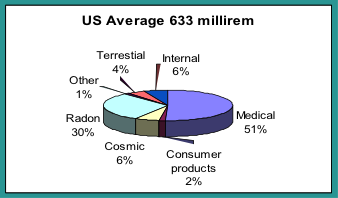The difference between man-made sources of radiation and naturally occurring sources is the location from which the radiation originates. The three major sources of human sources of radiation are:
- Medical sources
- Consumer products
- Atmospheric nuclear weapons testing
The following information briefly describes some examples of human-made radiation sources:
Medical Radiation Sources
The terms “x-ray” or “gamma ray” are sometimes used interchangeably however they are technically different. Even though x-rays are characteristically identical to gamma rays they are produced by a different mechanism. X-rays are produced by electrons outside of the nucleus; gamma rays are emitted by the nucleus. They are both an ionizing radiation hazard. A typical radiation dose from a two view chest x ray is about 0.2 mSv (20 mrem). A typical radiation dose from a whole body CT is about 15 mSv (1500 mrem). In addition to x-rays, radioactive isotopes are used in medicine for diagnosis and therapy.
Consumer Products
Examples include building products (contain naturally occurring radioactive materials) such as brick, granite counter tops, or phosphate fertilizer, tobacco products, and antiques such as clocks and watches (may contain radium or tritium so that the dial glows in the dark) or canary/vaseline glass. The radiation dose from consumer products is relatively small as compared to other naturally occurring sources of radiation and averages 0.1 mSv (10 mrem) per year.
Atmospheric Testing of Nuclear Weapons
Another man-made source of radiation includes residual fallout from atmospheric nuclear weapons testing that took place in the 1950’s and early 1960’s. Atmospheric testing is now banned by most nations. The average dose from residual fallout is about 0.02 mSv (2 mrem) in a year.
X-ray Machines
Any electronic device that has fast-moving electrons is a potential source of ionizing radiation. One example is a fluoroscope. An x-ray device was first used in 1896 and permitted non-invasive imaging of internal human structures. Today, in the US, medical procedures from ionizing radiation account for 51% of our average annual dose from radiation (the other 49% is from naturally occurring sources such as cosmic rays, radon, and soils).
X-rays
X-rays are a type of radiation commonly found in the hospital. These radiations are produced mainly by machines when high voltage electrons interact with matter. X-rays are a type of energy similar to light but like gamma rays pass easily through fairly thick materials. X-ray machines and the rooms they are used in have built-in shielding (for example lead or concrete) as needed. The useful beam is restricted by a cone or an adjustable collimator.
High Energy X-ray Machines and/or Accelerators
High energy x-ray machines, also called linear accelerators, which operate in the 4 MV to 25 MV energy range, are therapy machines used to treat primarily cancer.
Sealed Sources
Many devices use sealed radioactive sources because they provide a convenient, inexpensive source of ionizing radiation. Sealed radioactive sources are often made by encapsulating the salt or metal of a radionuclide into a welded metal container whose size typically ranges from smaller than a grain of rice to the size of a golf ball. The encapsulation ensures that there will be no dispersed radioactive contamination. Applications range from low activity alpha sources that are used in home smoke detectors to brachytherapy which is a form of radiotherapy where a radioactive source is placed inside or next to the area requiring treatment.

